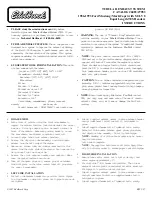
DRIVING TIPS
471
Maintenance
If you tow a trailer, your vehicle will require more frequent
maintenance due to the additional load. For this
information, please refer to the scheduled maintenance
information in the “Owner’s Manual Supplement /
Scheduled Maintenance”.
Retighten all fixing bolts of the towing ball and bracket after
approximately 1000 km (600 miles) of trailer driving.
Pre−towing safety check
Check that your vehicle remains level when a loaded or
unloaded trailer is hitched. Do not drive if the vehicle has an
abnormal nose
−
up or nose
−
down condition, and check for
improper tongue load, overload, worn suspension or other
possible causes.
Make sure the trailer cargo is securely loaded so that it
cannot shift.
Check that your rear view mirrors conform to any federal,
state/provincial or local regulations. If they do not, install
required rear view mirrors appropriate for towing purposes.
Trailer towing tips
When towing a trailer, your vehicle will handle differently
than when not towing. The three main causes of
vehicle−trailer accidents are driver error, excessive speed
and improper trailer loading. Keep these in mind when
towing:
Before starting out, check the operation of the lights and all
vehicle
−
trailer connections. After driving a short distance,
stop and recheck the lights and connections. Practice
turning, stopping and backing with a trailer in an area away
from traffic until you learn the feel.
Backing with a trailer is difficult and requires practice. Grip
the bottom of the steering wheel and move your hand to the
left to move the trailer to the left. Move your hand to the right
to move the trailer to the right. (This procedure is generally
opposite to that when backing without a trailer.) Also, just
turn the steering wheel a little at a time, avoiding sharp or
prolonged turning. Have someone guide you when backing
to reduce the risk of an accident.
Because stopping distance may be increased,
vehicle
−
to
−
vehicle distance should be increased when
towing a trailer. For each 16 km/h (10 mph) of speed, allow
at least one vehicle and trailer length between you and the
vehicle ahead. Avoid sudden braking as you may skid,
resulting in jackknifing and loss of control. This is especially
true on wet or slippery surfaces.
Summary of Contents for RX400h2006
Page 17: ...PICTORIAL INDEX xiii INSTRUMENT PANEL vehicles with navigation system ill full...
Page 19: ...PICTORIAL INDEX xv INSTRUMENT PANEL vehicles with center display ill full...
Page 21: ...PICTORIAL INDEX xvii INSTRUMENT CLUSTER vehicles sold in U S A ill full...
Page 23: ...PICTORIAL INDEX xix INSTRUMENT CLUSTER vehicles sold in Canada ill full...
Page 51: ...QUICK REFERENCE 24...
Page 145: ...GAUGES METERS AND SERVICE REMINDER INDICATORS 118...
Page 175: ...INTERIOR EQUIPMENT 148...
Page 272: ...OCCUPANT RESTRAINT SYSTEMS 245 Canada only Type A Canada only Type B...
Page 277: ...OCCUPANT RESTRAINT SYSTEMS 250...
Page 291: ...STEERING WHEEL AND MIRRORS 264...
Page 295: ...AIR CONDITIONING 268 Air flow selection...
Page 311: ...AIR CONDITIONING 284...
Page 364: ...AUDIO 337 Without navigation system...
Page 481: ...STARTING AND DRIVING 454...
Page 537: ...IN CASE OF AN EMERGENCY 510...
Page 559: ...INTRODUCTION 532 NOTICE Make sure to place the jack correctly or your vehicle may be damaged...
Page 577: ...HYBRID SYSTEM 550...
Page 583: ...CHASSIS 556 CHECKING TIRE INFLATION PRESSURE Type A Type B...
Page 608: ...ELECTRICAL COMPONENTS 581 Engine compartment Engine compartment Driver s side instrument panel...
Page 616: ...ELECTRICAL COMPONENTS 589 Engine compartment Engine compartment Driver s side instrument panel...
Page 625: ...ELECTRICAL COMPONENTS 598...
Page 637: ...BODY 610...
















































